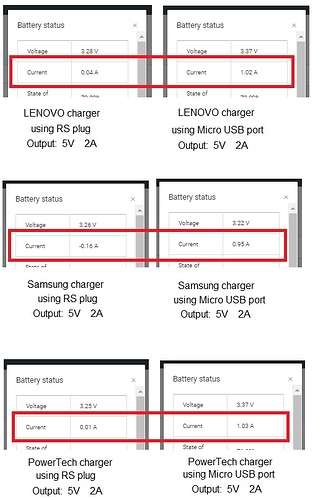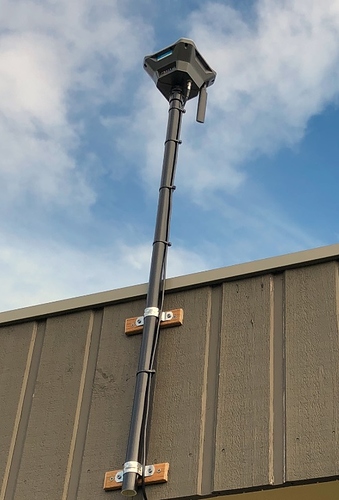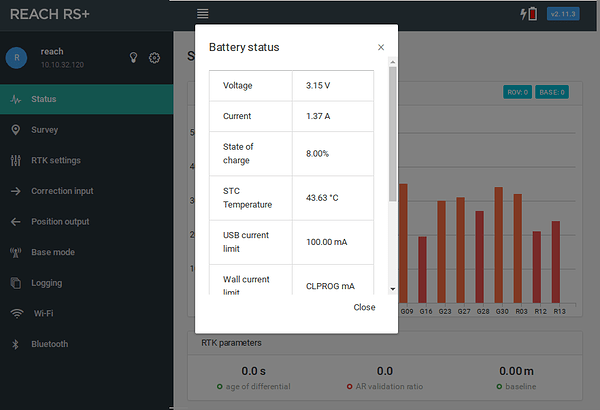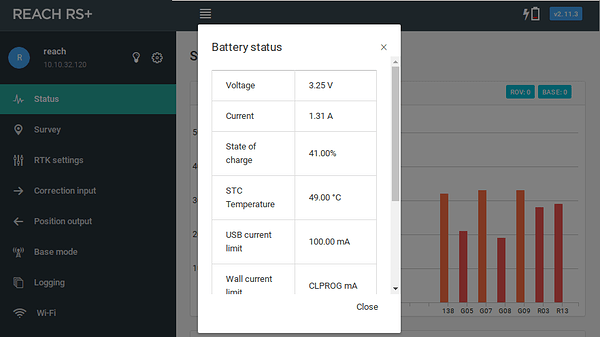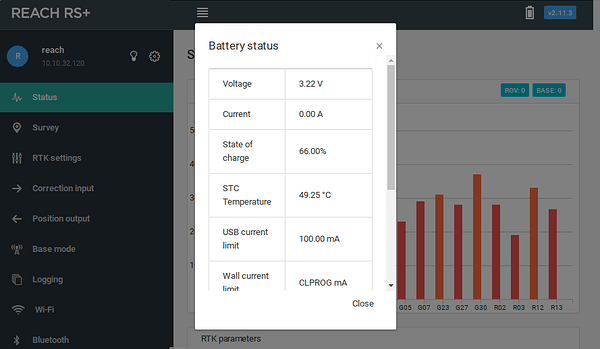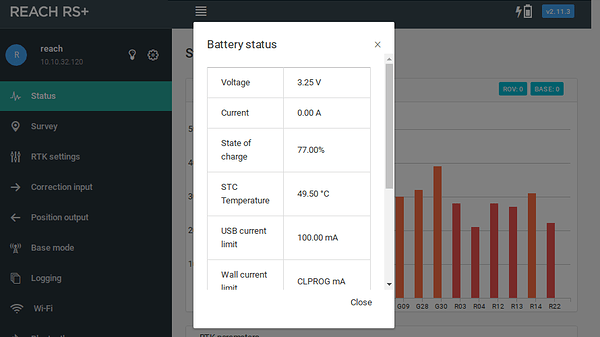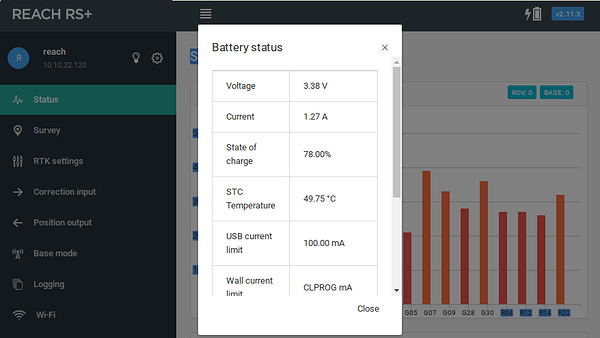Quick Google search and found lots of USB boosters, will have to try one.
USB-C can provide the voltage you need
Also, it is quite easy to find a 4-port USB powered hub that has a special “charge” port that will provide 2 Amps.
You could also replace the AC power adapter that comes with it with a DC power supply if you don’t have AC available.
??? I thought it was stated that the chargers and cables that were used to charge the units via micro-usb connection were working? So that was ruled out, but that was ultimately the problem apparently.
Either way, you got it worked out.
Thanks EMLID for such a great product!
I packed up my laptop and EMLID antenna this morning and took them to the local electronics shop. With the help of a very patient sales person proceeded to go through their entire stock of USB chargers, powered USB hubs and laptop power supplies… it would have easily been 20 to 25 different products. Only ONE device provided enough power to charge through the RS port, and its not much more than a trickle charge. I have been comparing the difference between the micro USB port and the RS port, and there is almost a 1 amp drop between the two (see results below), and this is consistent with all the cables that I have tried. I’m wondering if “bide” has a similar drop when you plug the same charger into the micro USB port?
I did not do extensive testing, I only verified that they did charge.
However, I did notice the current was low when first plugged in, like +.01 Amp or similar. Then after a minute passed, the current increased.
To verify that this is the normal behaviour would require another test. All my RS are fully charged right now, so I can’t do that test until one has been discharged.
Also, be aware that there are different modes to the charging program. There will be a bulk charge with a maximum set amperage, and then later there will be a constant voltage charge which will top it off (there may be other modes to the program as well, including temperature-related modes).
During constant voltage charging, the current is whatever the battery wants to take, so it could be very minimal, especially if the battery is almost full.
Of course this does not explain why you see a difference between ports, but the different ports may have different charge profiles or be controlled by 2 entirely different chips. People who charge by USB are usually wanting a fast charge. People who charge by the bottom connector probably have it permanently installed, so it really only needs enough current to operate the device and a tiny bit more to keep the battery topped up.
Just something to think about until we can do some experiments…
Yes, I noticed that too, that it takes about 30 seconds to establish a charge program, and those screen shots were after about a minute had passed. None of the antennas that I am testing with are fully charged, they were between 60% and 80%. My plan is to set up one of the antennas as a long-term test platform with the new PowerTech charger and continue to monitor the battery status. The frustrating part for us is that we need the RS plug to transfer data too, and we do not have any laptops that have been able to provide enough power through the RS plug. I might have to make a hybrid cable, with power coming from the charger and the data going to the USB plug.
I think there is more to the story too. Let’s see: We have many USB ports and plug adapters which apparently can not supply enough power. USB is spec’d to put out 500mA, and specific chargers can be 1A or perhaps 2A or more. Now, we have seen an on-screen indication of a charge of 0.12A through the bottom connector plus the typical draw which I think could be around 0.6A which makes 0.72A total. So yes for a stable setup, rule out any 500mA port right away, but anything of 1A or more should work. I think the testing should include an in-line ammeter plus a voltmeter, so one can witness the voltage drop on the line as well as the actual charge current. Now compare that to the reported charge current (plus typical RS operating current).
I have some other ideas as well, so I just started up an RS+ on a discharge cycle and will tackle this again in a day or so.
Yes, I like the idea of an inline ammeter/voltmeter, I will need to look into that.
I just feel that all this troubleshooting should not be occurring, I can’t understand why the device would be designed to require a 2A charge through one port and 1A charge through another???
Sure, but if you want to supply power with a USB cable without issue, then simply use the USB port. ( I know you that you don’t want to - and for a good reason which you mentioned above.)
So, if you want to use the bottom connector without issue, then maybe don’t go with the absolute minimum voltage. Switch gears and give it 12V from your vehicle system. Maybe even terminate your cable with a 5-pin Weatherpak connector set, and then off of that two cables: one hooked into 12V and ground (or terminated with a typical 12V power plug), and the other with the TX, RX, GND to a DE9 connector for your laptop.
Another related mental exercise without having to measure would be to calculate the voltage drop in that cable. My really good Samsung USB wall adapter was putting out like 5.00V bang on. Now you put that 5.00V down a 2 meter, 22 gauge circuit and what voltage do you have at the other end?
- At .12 Amps, it is 4.98V
- At 500mA, it is 4.93V (USB max spec)
- At 1 Amp, it is 4.87V
- At 2 Amps, it is 4.73V
So how much below the 5 Volt minimum can you go before RS simply won’t accept it? I think we are finding out that maybe it is .72 Amp which is 4.90V or so. 
(Calculations based on 22ga wire being 10.14 Ohms per 1000 ft at 20 Celcius, and not factoring in any resistance for connections, or any extra cabling to the USB connector or inside the Reach device. For full disclosure, I guessed at the 22ga wire size.)
-
I’m going to tack on here the notion that for each doubling in voltage, the current will be half, which means the voltage drop in the RS cable will also be half.
-
Also, in a round-a-bout way, I am saying even only adding 1 more Volt on the supply end could potentially allow for over 7 Amps of charge current through the cable while still delivering >5 Volts to the RS unit.
…testing to follow…
That is definitely an option, the input does say 5v - 40v. I was trying out some selectable power supplies this morning but kept it at 5volts. I may need to go back there and try them out with a higher voltage setting.
I’ve gone ahead and mounted the antenna as we need to continue with the system implementation; when I put the unit up the battery had a charge of 87%, its been just over an hour and it’s still at 87%. Which is ok, but will need to see what happens long term.
This is our base antenna, so all we need to worry about is keeping a charge going to it. We still need to mount the rovers inside vehicles, which is where they will be connected to a tablet via USB to collect and process the GPS data. Since the vehicle has a 12volt system, we might be able to use that. But I will need test with a 12 volt power supply… back to the e-shop…
Are you doing some accurate measure up there?
Wood is in constant movment to humidity, weather, temperature etc etc etc
By the look of the mount it could easly change back and forth the RS position by a 1cm or maybe more.
Just a tip if. You could have a controlpoint on the ground to monitor now and then to see if degrads with time
Yes, 1cm is still within our tolerance. We use a survey marker to set the base location, so that is something we could check once every 6 months, (summer v winter). If it does go out by much more than 1cm we would be able to adjust for it.
Nice base station install by the way!
So, I have an RS+ here that was finally discharged, and I caught it just in the nick of time. Madly grabbing cables and a power supply and the soldering iron, I managed to get it hooked up just after this point:
And here is it plugged in only seconds later:
The setup and the battery status (2 minutes passed):
Now 10 minutes have passed (input voltage at 11.02V):
Now 20 minutes have passed (input voltage at 11.00V):
Note the current is at zero. Lower down the battery screen was a HOT message. The charger started up a minute later, I assume after it cooled a bit
Now 25 minutes have passed, and here is the setup with the meter showing amperage:
Now 60 minutes have passed, and the charger has the HOT signal again. It is cycling on and off every minute or so:

Now 65 minutes have passed and it is charging again:
The conclusion is that the RS+ charges well with 11 Volts input to the bottom connector. It does not pull the theoretical 7 Amps as I might have predicted, but it certainly draws in over 2 amps and puts a good portion of that straight into the battery. It also is thermally smart and shuts down when it needs to.
It might be more interesting to test across a range of voltages, but that’s all I have in me today.
Thanks for that great info bide! Getting 1 amp through the RS plug looks very promising. It looks like you are simply using a computer power supply - great idea! Since I just installed my test cable on the base station, I will need to make a new one and then dig up an old power supply, if we get similar results, that should solve our problems. 
You are correct. For testing, I used an old AT power supply because it has the nice push-on, push-off switch. The issue is that it doesn’t work right unless it is under load (or so I’m told). I plugged in a hard drive to give it that load. Even still it wasn’t producing a full 12V.
Anyhow, a more contemporary ATX supply would work better and be more stable I think. You just have to trigger the power-on via one of the pins on the ATX connector.
Let is know how it goes!
Seems like the PC power supply is overkill. Aren’t some even just using solar panels?
It definitely is overkill with 200W or even 550W+ capability, supplying a 10W or so load. But if you have one sitting in the corner not doing anything…
There is another test (I leave it up to you this time  ). How efficient is a computer power supply at very low draw?
). How efficient is a computer power supply at very low draw?
Ok, I see. ; ) btw, your really just too helpful bide! ; ) ~
So is emlid going to sell a charge cable for permanent installs?
IE base stations, tractors …




